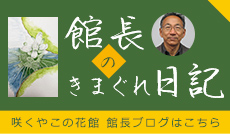ロウソクノキ

パナマのシャンブルリバーバレーChabres River Valleyの標高の低い常緑樹林に固有種として見られます。花は幹に咲き(幹生花)、緑がかった白です。受粉は主に蜜を好むコウモリにより行われます。当館の株は果実が着かなかったので、違うDNAをもつ枝を接ぎ木しました。今では一株でもよく実がつきます。
多肉質の果実は生や料理をされる事が稀にありますが、地域によっては家畜の餌になります。植物の各部分には医薬的に重要な成分が含まれています。それはフラボノイド、サポニン、ステロイド、タンニン、テルペノイドです。利用価値のあることで、国際自然保護連合は絶滅危惧植物にあげています。
Parmentiera cereifera is endemic to Panama at low altitude. The flower is greenish white with five lobed corolla, and blooms on the trunk. The flowers are mainly pollinated by nectarivorous bats. It is taper-shaped fruit, up to 60 cm long. The fleshy fruit is edible and it rarely consumed raw or cooked are locally utilized as food for the cattle. The common name, ‘candle tree’ is used also for Senna alata(Fabaceae) and Dacryoides excelsa(Burseraceae). The presence of flavonoid, saponin, steroid, tannin and terpenoid in various parts of this tree is worthy of further investigations for medical supplies. It is an endangered plant listed by IUCN(International Union for Conservation of Nature and Natural Resources)






